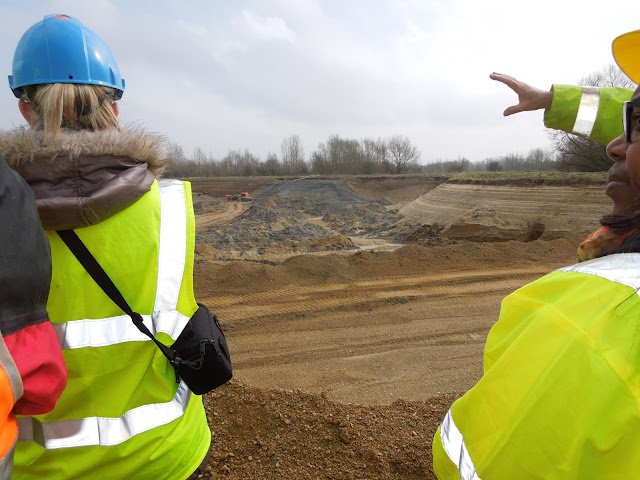The setting at Eynsham Hall is very picturesque and the facilities for courses are excellent. Last year I attended the course in the first month of starting in my post at the Project and felt quite overwhelmed by all the legislation and planning terms. It was a relief to be more familiar with the subject this year as I attended on the first day as one of the presenters. I talked about the origins of the Lower Windrush Valley Project proposed in the 90's in response to the increasing impacts of sand and gravel extraction in the valley and the work of the Project since it opened in 2001. I then introduced the site visit for the afternoon to the Gill Mill sand and gravel extraction site. Owned and run by Smiths (Bletchington) this site is perfect for viewing the complete process of extraction from beginning to end. Peter, the quarry manager, and Fred, the site foreman, showed us round the site.
We were able to see the next area for extraction where the surface soil had been stripped, with the top soil piled into bunds around the working area. These excavations are always accompanied by archaeological teams to record any finds before extraction commences and they can just be seen here working in the distance. Finds at Gill Mill have been quite considerable, especially from roman times with a road and quantites of pottery, coins etc.
Just 100 metres away we could also see the current excavation with an excellent view of the sand and gravels overlying the Oxford clay below. It was hard to believe that just a few weeks ago excavation was halted for several weeks as this site was completely under water due to the extensive flooding in the area. This pit will be restored to low level recreational use that has not yet been finalised, but will probably be for fishing of some description.
We then walked round Tar Lakes to see how the restoration, designed primarily for public enjoyment, has been achieved. Lakes, ponds and ditches, new blocks of woodland and hedging are all easily visible from new paths that are designed for wheelchair access. The public footpath that crosses the site along the eastern boudary has been left as a grassy path to provide a quieter more natural area.

Even with the frequent visitors that the Tar Lakes site is now attracting it will provide good habitat for many species of invertebrates, small birds and mammals and the odd coot, great crested grebe and mallard. There were great displays of dragonflies and damselflies here last summer.
We then visited the bird hide at Rushy Common Nature Reserve which is only accessible through the purchase of a key from the project office. The contrast between the nature reserve and the Tar Lakes site was very clear as we viewed the large numbers of birds in the reserve

Over 100 bird species have been recorded at this hide since it opened to the public in 2011. During the winter significant numbers of waterfowl have been resident here and during the summer waders, ducks and geese have nested here. If you are lucky you will see kingfishers and maybe a peregrine or sparrowhawk flashing by.
A key can be purchased for £10, giving 24hr access for the forseable future. Contact the LWVP project office tel:01865 815426. The key also gives access to the two hides at Standlake Common Nature Reserve.


No comments:
Post a Comment